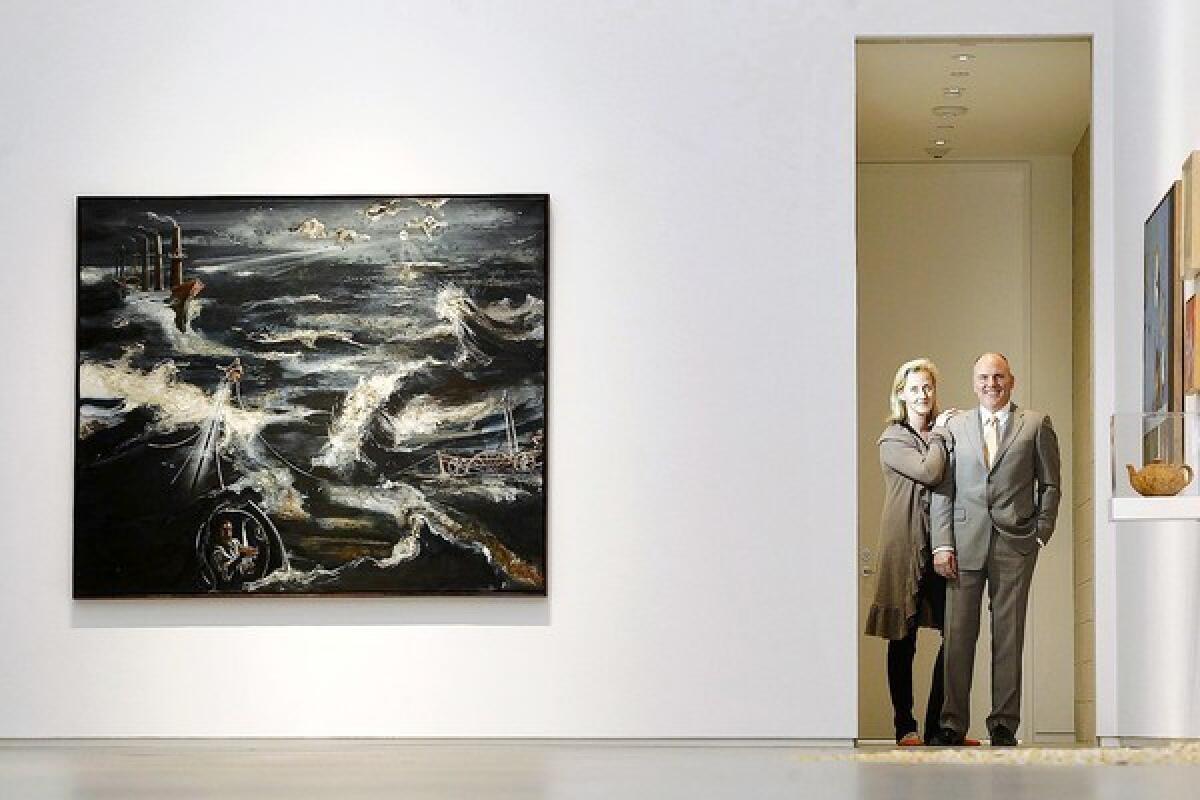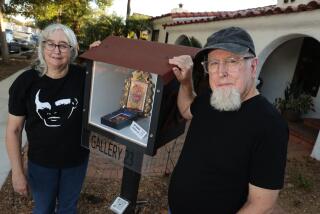At El Segundo Museum of Art, couple opens collection to public

- Share via
When a small but powerful 1826 painting by Corot of a craggy rock formation came up for auction three years ago at Sotheby’s in New York, Getty curator Scott Schaefer was working with a museum trustee who wanted to buy it.
When the trustee was outbid, Schaefer tracked down the winning bidders and was “absolutely shocked,” he said, to find that they lived so close: Brian and Eva Sweeney, a Manhattan Beach couple who were quickly and quietly building a serious art collection. “It could have gone anywhere in the world,” Schaefer said.
In May, Corot’s “Civita Castellana” will be loaned to the Getty Museum and hang in its 19th century galleries. But until then, it has pride of place at a new nonprofit art space founded by the Sweeneys: the El Segundo Museum of Art, which opened to the public last week.
PHOTOS: Arts and culture in pictures by The Times
It is a tiny museum, with about 2,000 square feet of exhibition space, no permanent collection and only one person on staff full time (with two part time — all in education). Curator Bernhard Zuenkeler, who lives in Berlin and makes frequent trips to L.A., is Eva Sweeney’s older brother.
But the small space has big ambitions to bring visual art to a town better known for its Chevron refinery and its proximity to Los Angeles International Airport. The first show, drawn primarily from the Sweeneys’ collection, features 19th century greats like Corot and Gustave Courbet mixed with more recent work by Christo, Andreas Gursky and young German artists.
The plan for the nonprofit space — the Sweeneys call it a “laboratory” — is to invite local teachers to use the exhibitions as they see fit during the week, and to keep public hours Friday through Sunday.
The couple originally planned to convert an alley along a property on Main Street in El Segundo into storage for their growing collection. But former mayor Eric Busch encouraged them to open it up to the public.
With three children younger than 7 at the time, the Sweeneys started thinking about arts education.
“Our kids went to public school in Manhattan Beach and the arts program was reduced there,” said Eva, 43. “We know that getting access to art is a struggle for schools sometimes, so this is a way for them to see real art instead of reproductions or slides.”
And the schools don’t even need to rent a bus. As Brian, 51, pointed out, El Segundo has four public schools — one high school, one middle and two elementary, all within walking distance. “It’s our objective to have all kids in the school system come through our space. They can just walk over,” he said.
This project also draws on the Sweeneys’ professional strengths. Before they were married in 2002, Eva was the co-founder of the Los Angeles architecture firm Bau10, having left her native Germany to do graduate studies at Southern California Institute of Architecture.
Brian is a real estate developer famous (some would say notorious) for buying up huge expanses of coastal land and selling it at a profit to parties seeking to protect it from big development. At one point he owned 3,000 acres in Malibu. The two met when he hired her firm to design dozens of high-end homes there.
PHOTOS: Arts and culture in pictures by The Times
Brian was the one who saw the potential of a 15-foot alley just north of the El Segundo post office to become a building. He bought the full property, post office and alley, in 2010. When the post office downsized soon afterward, he used some of its space to turn the alley into a 25-foot legal lot. (The post office has since closed, and he is now trying to lease the space to a restaurant.)
Eva designed the museum space with an emphasis on both sustainability and beauty, using burnished concrete blocks for the walls and solar tubes as lights. She also created an airy “education lounge” that overlooks the gallery, while the rest of the second floor has a sleek apartment for an artist in residence to use.
The Sweeneys plan to show artwork from various owners, but the first exhibition draws heavily on their own collection, which they have been rapidly building over the last five years.
They started with contemporary, and Eva remembers their first major purchase, a Peter Doig painting at Art Basel. “We were hooked,” she said. They soon branched into historical works, all the way back to the 15th century in the case of one engraving of witches by Dürer.
Their main areas of focus tend to be landscapes, work with architectural imagery, and nudes, with an emphasis on paintings and drawings. They now own about 400 works, serious enough to attract Getty attention.
Zuenkeler, who has advised them on their purchases, said Eva tends to favor the cleaner, more architectural imagery — Apollonian to Brian’s Dionysian streak. And Brian often makes the first move.
“He is very much an independent collector ... and he’s willing to take risks,” said Scott Schaefer at the Getty, who got to know the couple after their Corot purchase. “They are both passionate collectors who are willing to share their enthusiasm.”
The Sweeneys currently participate in three Getty councils or support groups: one for paintings and conservation, another for drawings, and a third helping the Getty Research Institute that Brian has chaired for a year now. And they have already loaned works to the museum, including four works on paper for the recent Gustav Klimt exhibition.
Eva said of her husband, “When he gets into something, he really gets into it.”
People who know about his real estate deals might wonder if he’s speculating in the art market.
Brian Sweeney said no. “We are doing this because it’s something we like to do together. I’m not trying to make money off of art,” he said. “Hopefully I can convince my kids to keep it, though their kids might sell it off. But you won’t see a big sale in my lifetime.”
Rather, he recognizes the value of an arts space in bringing visitors to the neighborhood and improving property values. Brian mentioned collectors Don and Mera Rubell’s exhibition space in the Wynwood district of Miami as a point of inspiration.
“They’ve changed the whole neighborhood — you can still see remnants of what it once was, but architects and restaurants have moved in,” Brian said. “We hope to have an effect like that in a small way.”
Unlike the Rubells, the Sweeneys decided to keep their name off the space. They say it was intentional, signaling that they plan to organize shows from other collectors and collections — not relying just on their own.
The first show, running three months, features the theme of nature — a rather conventional subject made fresh by the mixing of classic and contemporary works and an unusual display.
The space itself is narrow, so you don’t get the viewing distance typical in museums. Artworks were hung at different heights, some as high as 12 feet from the ground and others as low as one foot off the ground — prime viewing for the K-6 set.
“We want it to feel inviting, not intimidating, like you’re stepping into someone’s home,” said Zuenkeler.
The mixing of works from different periods also gives the show a certain vitality. “We’re showing how contemporary artists are classic, and how classic artists are pretty contemporary,” he said. “The work ranges from French realists who first did plein air [open air] painting to try to capture nature as is to young artists today who have a more fearful view of nature.”
One of the younger artists in the show, the 30-year-old Cologne-based Michael Sistig, is also their first artist in residence. (They have asked the Otis College of Art and Design to choose others for one three-month term each year.) He has two paintings in the show. The largest is a wild and densely detailed Hieronymus Bosch-style seascape called “Anti-Ark” in which Noah’s ark provides little refuge and biblical characters like Jonah are set adrift in the dark, churning waters.
Sistig is also creating a large installation for the beach at El Segundo that explores issues of climate change, a commission by the Sweeneys. It involves massive shipping containers, a sculpture of an emaciated pink polar bear and another sculpture of a mythical siren who calls sailors to their death, and the plan is to install it by Friday.
Before that he was putting finishing touches on the sculpture in a rather raw space a block away from the new museum. Behind his giant polar-bear-in-progress stood racks of paintings wrapped in plastic.
Yes, this building also belongs to the Sweeneys. Brian laughed. “That’s the only problem with turning our storage space into a museum,” he said. “We needed more space for storage.”
----------------------------
El Segundo Museum of Art
Where: 208 Main St., El Segundo
When: Open Friday through Sunday, 10 a.m. to 5 p.m. (Open Monday through Thursday by appointment to school groups and private parties.)
Contact: (424) 277-1020, https://www.ESMoA.org
MORE
INTERACTIVE: Christopher Hawthorne’s On the Boulevards
VOTE: What’s the best version of ‘O Holy Night’?
PHOTOS: Arts and culture in pictures
More to Read
The biggest entertainment stories
Get our big stories about Hollywood, film, television, music, arts, culture and more right in your inbox as soon as they publish.
You may occasionally receive promotional content from the Los Angeles Times.










